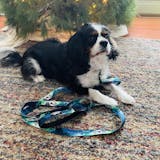Walks should be relaxing and enjoyable for both of you and your little guy, but if you have a dog pulling on a leash, the experience can quickly turn into a frustrating tug-of-war. Dogs pull for various reasons, and while training is essential, having the right leash can make a world of difference. In this guide, we’ll dive into what causes pulling, share some tips on how to fix the behaviour and explore the best types of leashes for dogs that pull.
Why Your Pooch Pulls on the Leash
Understanding why your dog pulls on his or her leash is the first step toward correcting it. Pulling is a natural response for many dogs, and oftentimes, it has nothing to do with disobedience.
Excitement
Dogs are naturally curious creatures. When they’re out on a walk or hike, even following a route they've taken dozens of times, they’re surrounded by new smells, sights, and sounds. This sensory overload can lead to excitement, causing them to want to forge ahead and explore.
Reactivity
At the opposite end of the spectrum, some dogs pull when they’re anxious or feeling reactive. Whether they’re eager to greet other dogs, trying to chase a squirrel, or feeling uneasy about new surroundings, heightened emotions can cause dogs to pull.
Lack of Training
If your dog hasn’t been properly trained to walk on a leash, he might not understand what you expect. Without firm guidance, pulling becomes the default mode for some dogs.
Instincts
Certain breeds, especially those bred for working or pulling such as huskies or Saint Bernards, have a natural inclination to lead—it's very literally in their DNA. This doesn't mean you're facing a life of your dog pulling on a leash forever, but you will have to work hard to counteract their instincts.
Comfort and Fit
Sometimes, dogs pull simply because their leash or collar is uncomfortable or too tight. They may be trying to escape the irritation. That's why choosing the right leash is so effective in addressing the behaviour.

What are the Best Types of Leashes for Dogs That Like to Pull?
When it comes to choosing the best leash for dogs that pull, it's important to understand that they’re not all created equal. Design and features matter, with some providing better control and reducing pulling. We offer a range of leashes tailored to meet these specific needs.
- Adjustable All-Mountain Dog Leash: By far one of the best leashes for dogs that pull, our do-it-all leash checks just about every box. The All-Mountain leash is shock-absorbing, with a stretchy webbed section that stretches ever so slightly when your dog pulls, reducing the impact. It also has a comfortable neoprene cushioned handle and can be worn hands-free or as a traditional hand-held leash.
- Hands-free Leash: A major contender for the best leash for dogs that pull, hands-free options generally go around your waist or chest. This inherently keeps your doggo close and prevents you from constantly correcting her. Note that a hands-free leash may not be the best option for very large dogs since one pull could knock you off balance!
- Leashes with Traffic Handles: Our 'everyday' leash has an integrated traffic handle, sometimes also called a heel handle. This allows you to keep your dog close (and hence, reduce pulling) in situations that require extra control, such as crossing the street or walking through crowded areas.
Types of Leashes to Avoid
While many leashes are designed to help reduce pulling, there are also several types that can actually make the problem worse or even be dangerous for your dog, making walks more challenging and increasing the risk of injury. Here are some leash types you may want to steer clear of.
Retractable Leashes
Although extremely popular, these are the worst leashes for dogs that pull. The constant tension on the leash actually encourages pulling, and the thin cord can be difficult to grip, resulting in less control. If the cord snaps, it could cause injury to you and/or your dog.
Thin Leashes
Thinner leashes and those made from flimsy materials can easily fray or snap, especially if your dog pulls hard. Always, always opt for a thicker, sturdy leash that can withstand the force of a pulling dog.
Chain Leashes
There's no denying that chain leashes are strong, but they're also heavy and uncomfortable for both you and your dog. The added weight often makes pulling worse, as a dog may pull even harder trying to move the heavy leash.
Too-Long Leashes
It sounds appealing, right? Giving your dog more freedom to roam on a longer leash. For a pup that pulls, though, it's counterproductive. The extra length gives them more leverage to pull harder, making it harder to control them.

What to Do if Your Dog is Pulling on the Leash
If you’re struggling with a dog pulling on a leash, switching to one designed for better control is a great first step. However, there are also several strategies you can implement to help curb the behaviour.
- Keep walks engaging: Remember, dogs often pull because they’re excited or bored. Keep walks interesting by taking different routes, incorporating training exercises or games, and allowing your dog time to sniff and explore in safe areas.
- Practice loose-leash walking: Train your dog to walk beside you with a loose leash. Reward them when they walk calmly next to you, and stop walking immediately when they start to pull. Over time, your dog will learn that pulling doesn’t get him anywhere...literally!
- Use positive reinforcement: Reward your dog with treats, praise, or even new toys when they walk nicely on the leash.
- Try a no-pull harness: Pairing a great dog leash for pulling with a comfortable harness can offer you better control and reduce your pup's ability to race ahead.
- Upgrade to a Rocky Mountain Dog leash: Our team is made up of active dog lovers, and our leashes are designed with both humans and dogs in mind. Whether you choose an all-weather biothane leash, a hands-free leash, or another option, simply switching to a higher-quality leash can go a very long way in reducing pulling.


